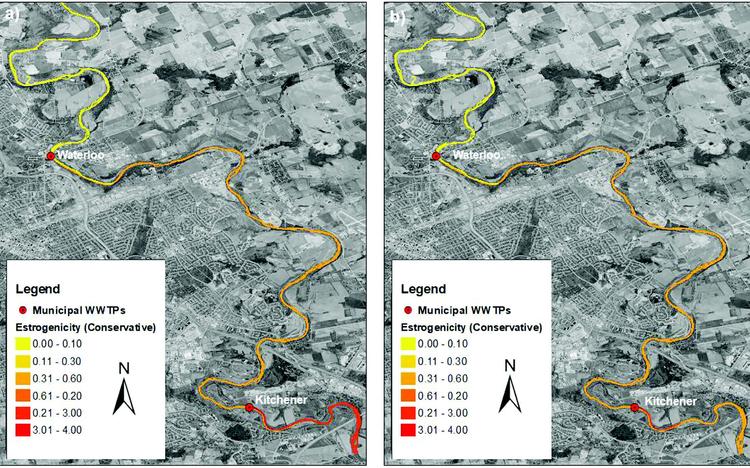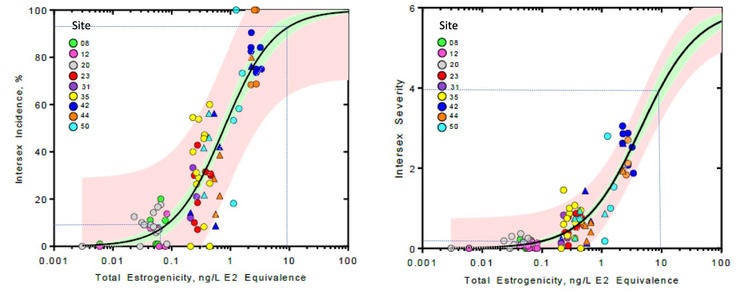The exposure of fish to endocrine active chemicals (EACs) has been shown to have deleterious consequences for reproductive health, such as the presence of both male and female characteristics in the same fish (intersex). The European Union (EU) has proposed thresholds for the release of EACs to the environment, however these are below detection limits of routine chemical analysis. Despite the considerable chemical and bioanalytical monitoring of EACs in effluents and receiving environments worldwide, there is still limited information to assess the spatial and temporal concentrations of EACs in receiving waters, where analytical challenges and costs are important considerations for current monitoring efforts. In the absence of such data, the modelling of environmental systems can be used as an alternative approach to characterize fish exposure to EACs, and to evaluate current and future mitigation strategies for eliminating target compounds.
In this study, the concentrations of natural estrogens (E2 and E1) and synthetic estrogens (EE2) were simulated along the Grand River in southern Ontario, Canada, where the widespread presence of pharmaceuticals, personal care products, and intersex in male rainbow darter (Etheostoma caeruleum) has been documented. A major upgrade in one of the treatment plants has resulted in significant effluent quality changes during the study period, providing a unique opportunity to apply models that can help assess the efficiency of the upgrade. The overall goals of this study were therefore to estimate the concentrations of E1, E2, and EE2 through mechanistic water quality modelling and to determine whether the exposure to these key estrogens is consistent with the observed intersex responses in wild fish.
Methodology
The Grand River watershed (~6,800 km2) drains into Lake Erie and is inhabited by close to 1 million people. Approximately 80 kilometres of the river was modelled, capturing both agriculture and urban land uses and incorporating inputs from two major (Waterloo and Kitchener) and two smaller waste water treatment plants (WWTPs). In 2012, the Kitchener WWTP underwent major process upgrades including improved aeration, nitrification, and replacement of chlorination/ de-chlorination with UV effluent disinfection.
The water quality modelling included three separate components: (i) source, (ii) transport and fate, and (iii) effects. The source modelling predicted the effluent concentrations from the target WWTPs, while the transport and fate component (i.e. Water Quality Simulation Program) simulated the distribution of target EACs. The effects component evaluated the potential relationship between the predicted river concentrations and field-recorded intersex conditions in rainbow darter.
Four major steps were completed to predict the river concentrations: (i) discretization of the river network, (ii) simulation of river transport mechanisms, (iii) testing of the transport processes using a tracer compound (chloride), and (iv) integration of organic compound modelling through the addition of significant in-river fate mechanisms such as biodegradation and photolysis.
The major inputs of target estrogens were assumed to be from four WWTPs. Biodegradation and photolysis were modelled as first-order reactions, with constants derived from the literature. A dataset of intersex incidence and severity from 2007 to 2015 at nine different sites, including periods prior to, and after, the Kitchener WWTP upgrades, was used as the primary biological response to which the predicted EAC concentrations were compared.
Outcomes
The suitability of model discretization, hydro-geometry, and transport conditions was verified through comparison of model simulations with measured data for water levels and chloride concentrations at selected sites. The concentrations of estrogens in the river were simulated conservatively (assuming no degradation), as the addition of biodegradation and photolysis loss mechanisms did not significantly change the results.
The concentrations of the target estrogens at sites immediately downstream of the two major WWTPs were predicted. E1 was predicted to be the most abundant and contributed, on average, 51 per cent and 65 per cent of the total estrogenicity below the Kitchener and Waterloo WWTPs, respectively. In contrast, EE2 (most potent of the estrogens) only contributed 17 per cent to 18 per cent of the total estrogenicity in the river segments immediately below the WWTPs. Historically, less attention has been given to E1 due to its lower potency relative to E2 and EE2. However, as observed by this modelling study and many monitoring surveys worldwide, E1 can be present at much higher concentrations than its more potent counterparts.
The impact of river flow on predicted estrogenicity concentrations in the river is evident: low flow periods had high predicted concentrations and vice-versa. Furthermore, as the removal rates in the river via biodegradation and photolysis were determined to be minimal, the critical exposure conditions are controlled by dilution and will therefore most likely occur during low flows. The average predicted total estrogenicity at low flow conditions was 0.45 ng/L E2 equivalents immediately downstream of Waterloo WWTP, 3.4 ng/L E2 below the Kitchener WWTP prior to the upgrade, and 0.7 ng/L E2 equivalents after the upgrade.
The model was used to predict spatial patterns of estrogenicity concentration in the river in pre- and post-upgrade periods during low flow conditions. Elevated estrogenicity concentrations were predicted below the Waterloo WWTP that persisted until the last modelled segment. The highest concentrations were predicted immediately below the Kitchener WWTP. However, estrogenicity concentrations at all segments downstream of this plant were substantially reduced to 0.5 ng/L E2 equivalents when process upgrades were implemented (Figure 1).

Figure 1: Spatial conditions of total estrogenicity: (a) low flow condition pre-upgrade (May 20, 2012) and (b) low-flow condition post-upgrade (June 11, 2014).
Although a direct causal relationship was not established, the model provided predictions that fit very well with the observed intersex data for wild fish (Figure 2). The concentration-response relationship suggested that a predicted river total estrogenicity of 10 ng/L would be associated with the feminization of 93 per cent of adult male rainbow darter, corresponding to a predicted mean intersex severity score of 4 (severely intersex fish have scores of 4–6). Although an estrogenicity of 10 ng/L E2 equivalents was never predicted, the high incidence of intersex (80–100 per cent) observed downstream of Kitchener WWTP corresponded to an average predicted total estrogenicity of ~2.5 ng/L E2 equivalents. After the Kitchener WWTP upgrade, the predicted estrogenicity immediately below the WWTP ranged from 0.1 to 0.6 ng/L E2 equivalents, and was associated with an 11 per cent to 43 per cent intersex incidence with a severity of 0.1. The post-upgrade simulations suggest that the levels are approaching the background conditions.

FIGURE 2: Relationship between predicted total estrogenicity and (a) intersex incidence and (b) intersex severity (error bars are standard errors). The total estrogenicity data were the averaged concentrations from June–August, the period assumed in this study as the critical window of exposure. The shaded region represents the 95 per cent prediction (red) and confidence (green) intervals. Circles represent the sites with biological data and the triangles represent the post-upgrade period datasets for segments 42, 44, and 50. H= Hillslope parameter and F is EC50 (ng/L).
Conclusions
Decades of studies on endocrine disruption have suggested the need to manage the release of key estrogens from municipal WWTPs. However, proposed thresholds are often below the detection limits of most routine chemical analysis, thereby restricting the ability of watershed managers to assess the environmental exposure appropriately.
In this study, we demonstrated the utility of a mechanistic environmental water quality model to address the data gaps on estrogen exposure. Concentrations of the prominent estrogenic contaminants in wastewaters were simulated in the Grand River for nine years, including a period when major WWTP upgrades occurred.
The predicted concentrations were contrasted to a key estrogenic response of intersex in rainbow darter. A predicted total estrogenicity in the river of ≥10 ng/L E2 equivalents was associated with high intersex incidence and severity, whereas concentrations <0.1 ng/L E2 equivalents were associated with minimal intersex levels. Exposure to a predicted river concentration of 0.4 ng/L E2 equivalents, the environmental quality standard proposed by the European Union for estradiol, was associated with 34 per cent intersex incidence and a very low severity score of 0.6. This exposure is not predicted to cause adverse effects in rainbow darter. In addition, the study suggested that the Kitchener WWTP upgrades significantly decreased estrogen exposures downstream.
The analyses completed in this study were only based on the predicted presence of three major estrogens, so caution must be exercised when interpreting the results. Nevertheless, this study illustrates the use of models for exposure assessment, especially in cases where measured data are not available, which is currently more often the case than not.
Arlos, M.J., Parker, W.J., Bicudo, J.R., Law, P., Hicks, K.A., Fuzzen, M.L.M., Andrews, S., Servos, M.R., (2018). Modelling the exposure of wild fish to endocrine active chemicals: Potential linkages of total estrogenicity to field-observed intersex Water Research, 139, 187-197.
Contact: Mark Servos, Department of Biology
For more information about WaterResearch, contact Julie Grant.







